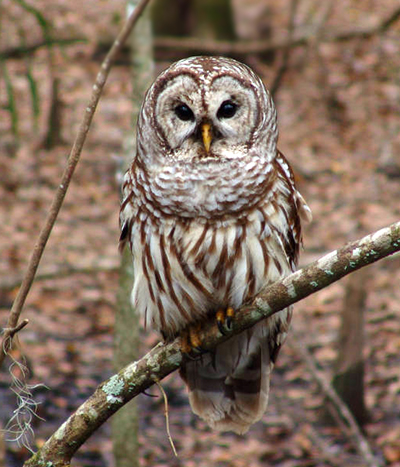Overview
 Barred Owl. USFWS photo.
Barred Owl. USFWS photo.
Barred Owls (Strix varia) were historically residents of eastern United States, southern Canada, and disjunct regions of south-central Mexico, but have expanded into western North America and now occur throughout the range of the Northern Spotted Owl (Strix occidentalis caurina) and California Spotted Owl (Strix occidentalis occidentalis) (PDF). Barred Owls were first detected in California in 1976, but large numbers of detections did not occur until the 1990s and 2000s. Today, nearly 2,000 Barred Owl records exist within CDFW’s species database throughout the entire range of the Northern Spotted Owl, and even further into the California Spotted Owl range in the Sierra Nevada.
Barred owls are larger, more aggressive, and have a broader suite of prey and habitat preferences than spotted owls. Research has demonstrated negative impacts of Barred Owls on Northern Spotted Owl populations at a range-wide level, which includes altered behavior (e.g., reduced calling of spotted owls), displacement from preferred high quality habitat, decreased survival and occupancy rates, and increased extinction rates. Within the three California demographic study areas (NW California, Hoopa, and Green Diamond), Barred Owl numbers have continued to increase, while Northern Spotted Owl populations, occupancy and apparent survival have declined substantially. The only exception to this is in an area where Barred Owls were experimentally removed on the Green Diamond treatment area. Given the ongoing rapid colonization of Barred Owls into the California Spotted Owl range, we expect similar impacts to this subspecies in the near future.
Given the level of decline of Northern Spotted Owl associated with the presence of Barred Owl and the impending threat Barred Owl expansion poses to California Spotted Owls, management actions (e.g. removal of Barred Owl, targeted forest management) should be considered in order to stem the ongoing declines. The US Fish and Wildlife Service (Service) is conducting a range-wide experimental Barred Owl removal study to test the feasibility of removal and determine whether it improves conditions for Northern Spotted Owls. The study includes removal on only a small percentage of the entire Barred Owl range. If the experimental removal is successful at improving Northern Spotted Owl populations, the Service may consider wider scale treatments as part of a management strategy.
Submission of Barred Owl Data
CDFW manages a supplemental Barred Owl dataset as part of the larger Spotted Owl Observations Database. You can submit Barred Owl data by sending directly to owlobs@wildlife.ca.gov. Data can also be entered and submitted using the PDF version of the CNDDB Field Survey Form.
Barred Owl Science Team
The Barred Owl Science Team (BOST) is an independent advisory group composed of subject matter scientists. BOST was convened by the Department in 2017 to address the threat of Barred Owl to both Northern Spotted Owls and California Spotted Owls in California. The purpose of BOST is to provide objective scientific review and recommendations to the Department to promote the recovery and conservation of spotted owls.
BOST Products